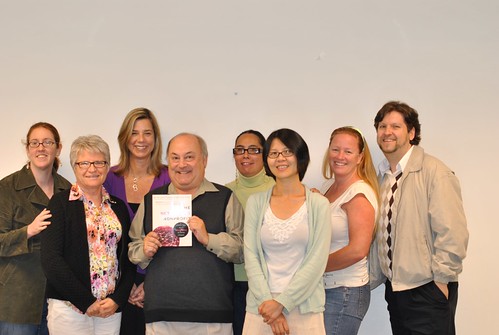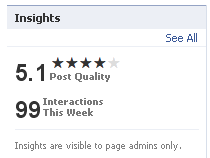
This year my work as Visiting Scholar at the David and Lucile Packard Foundation includes training, coaching, and facilitating peer learning sessions for grantees on using social media effectively, becoming a Networked Nonprofit. It has been incredible laboratory to put the big ideas in the book in practice.
I’ve had the pleasure working with one of grantees in the Local Program, the Arts Council of Silicon Valley, to coach them in making the transition to being a Networked Nonprofit. There is a wide range of comfort levels and experience using social media on staff, including the social media gurus who manage the Artsopolis which is focused on marketing the arts in SV.
This is an interesting process of spreading the expertise and way of working to all parts of the organization. This is a fairly small staff, with limited resources. As we discussed the challenges of culture shifts, many of the concerns were around lack of time. The Arts Council’s leader, executive director Bruce Davis, came up a great idea. “Let’s make the process of experimenting fun – let’s start with a Facebook Friday.” Their experiment is going to be focused on deepening and improving their Facebook presence for the Arts Council and getting everyone on staff to participate. Stay tuned for more …

Sharing Some Facebook Friday Insights
I like to have fun experimenting and that’s just what I’m doing on my Facebook Page, a place for learning, and sharing insights about best practices in social media for networked nonprofits. I learn so much from the conversation threads and people sharing what they do. I’ve been remiss in summarizing some of the nuggets out here on the blog, so here goes.
Facebook Strategic Objectives
I asked folks on Facebook: “What is your organization trying to accomplish on Facebook with its Fan Page?” Here’s a few answers:
- To disseminate short stories that are unique to the fan page, as well as to link to articles on our websites. We are much more successful when the stories come with a blurb than when they are simply automated RSS-feeds.
- To keep up with our friends, to empower them to tell their stories to the world, to find out what they need from us, to introduce them to each other, to offer mission-related action items, and to have fun.
Techniques for More Engagement
Someone said to me during a workshop a few weeks back – it really sucks to log into Facebook and see a two-star post quality ranking. This prompted me to post a question on my wall: How many of you Facebook Page admins notice your post quality ranking every time you visit? What I learned is that “drive by” analysis of metrics is really a waste of time. You need to grab the month’s worth of measures and look at them against your content.
Some folks have been puzzled by the Post Quality score which is determined by the percentage of your fans that engage when you post content to your Page. (It is calculated on a rolling seven-day basis… See More. The number of stars depends on how your Post Quality compares to similar Pages (for example, Pages that have a similar number of fans.)
Holly Ross simply ignores it and track the number of comments and likes on individual posts. Jon Dunn does something similar: “I prefer to really try to key in to what days were successful in terms of content. Understand why we had more new fans on a certain day. What about a certain post created that big conversation. Rinse and repeat.”
That particular wall post had 31 comments and 15 likes, way higher than other types of posts. Even better than the numbers was the knowledge nuggets shared. And, ah, I found the secret sauce: Simply Asking Questions That Allow People To Share Their Knowledge and Ideas sparks engagement!

Is there an App for that?
I have been wanting to test a poll app to see if having close-ended questions or running a poll might encourage engagement. So I installed this app and set up a poll “Do you think polls increase engagement? Yes or No?” Of the 43 people who took the poll, 89% said yes. Those who didn’t participate in the poll at all, but did on my wall asking for their feedback on polling apps said they didn’t like that the app asked for their personal information.
So, sometimes, the simple approaches work better.
A Couple of Useful Tools To Streamline Workflow
I asked an open-ended question “What are your Facebook administrator best practices?” This produced a rich conversation on techniques. This was the first time I noticed people posting on the wall taking to one another, not me. The thread also includes some great nuggets about streamlining the content strategy as well as streamlining interactions with fans.
- NutShell Mail is an software that aggregates comments and likes on your fan page and delivers it in one email. Manny Hernandez shared this link to a post about it.
- Spredfast is a listening/content distribution tool. One feature that I like is that it will give you a list of the names of fans and how much a like/comment.
- There is a way to link google analytics to FB insights.
A Couple of Good Facebook Links
I share about 2-3 really juicy how to links about Facebook a week. Here’s a couple that got the most likes or comments over the past month or so:
How To Contact Facebook for Help: Directory of Help Forms
Ten Cool Status Update Tricks
Be Careful Not To Violate Facebook Promotional Guidelines With Contests
Four Proven Steps to Facebook Page Success
Top Six Social Media Mistakes and How To Fix Them
Creating a Custom Landing Tab
Facebook Book For Your Desk
Finally, Mari Smith has co-authored a book, “Facebook Marketing: An Hour A Day” – if you want one book about Facebook best practices that combines tactical and strategic – this is it!
